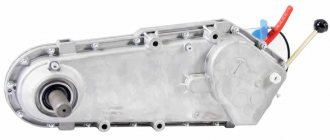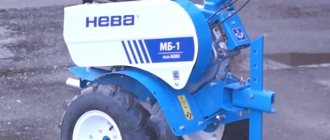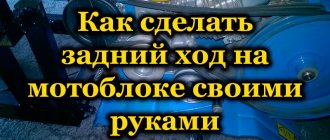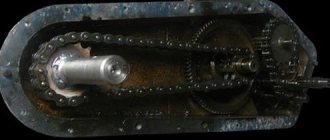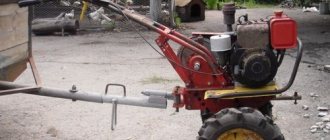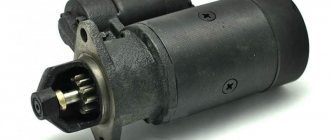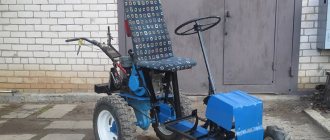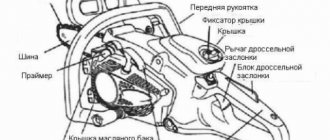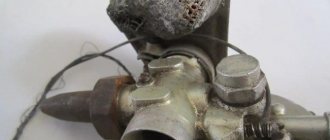Neva walk-behind tractor engine
The main working unit of a walk-behind tractor is the engine. It is activated only by turning the key; if the Neva walk-behind tractor does not start, then there are several possible reasons.
The walk-behind tractor does not start
No spark
In this case, it is necessary to check its functionality. Remove the spark plug from the engine and insert it into a special candle holder, and place the housing on the cylinder. Next, turn on the engine. If there is no spark, then you can replace the spark plug; if it does not appear, you should check the starting mechanism and ignition operation. Most often, it is the start button that fails; it can be replaced with a new one.
How to remove a candle correctly?
A special key is used to remove the spark plug. You must be careful, because the spark plug heats up during operation, so remove the spark plug before starting or after the walk-behind tractor engine has cooled down. We install a new one, and then check the clearance. It must be, but not big. The recommended lumen width is 0.5-0.6 mm.
Gasoline does not reach the engine
The second reason that the engine does not start is a problem in the supply of the fuel mixture. In this case, you should go through the complete gasoline delivery scheme. From the fuel tank to the carburetor.
- First check if there is fuel in the gas tank. It should not only be, but be 2-3 cm higher than the bottom, since the gas tank in the Neva walk-behind tractor is designed in such a way that fuel is taken at exactly this height.
- If there is fuel, you should check the operation of the gasoline intake valve. To do this, remove it from the hose and look, if gasoline flows out, then everything is fine, if not, you can clean the tap itself or replace it with a new one.
- Next, check the hose that connects the faucet to the carburetor. Remove it and try to blow it out. If air flows freely, it is functioning well. If not, clean it or replace it.
- And the last in this chain is the carburetor. Disassemble it and thoroughly wash all parts with 95 gasoline. Thanks to this, carbon deposits and impurities will be washed off. After completing the work, thoroughly blow all joints and joints with a compressor to minimize residual gasoline, which evaporates under air pressure. After this, put all the parts back together.
Here are a few more problems that may arise with the engine of the Neva walk-behind tractor:
The walk-behind tractor turns off during operation. Here the main reason is the low amount of fuel, since if it starts, it means it is in good condition. Since we discussed the design of the gas tank earlier, for reliable operation the fuel should be approximately 5 cm above the bottom.
The walk-behind tractor does not start the first time. Check the performance of the spark plugs and replace them with new ones if necessary. Also use a primer to additionally pump gasoline to the carburetor.
Running in the walk-behind tractor
After you have purchased a walk-behind tractor, you need to test it. This process must be carried out efficiently. Because it is the basis for the correct and durable use of equipment.
Running in a walk-behind tractor is, in essence, not operating it at full capacity. Here you need to select the correct load on the walk-behind tractor.
It is recommended to run-in the Neva walk-behind tractor with Subaru engines at half the maximum power. For example, if a plow in working condition should be lowered into the ground by 30 cm, then during operation it should be submerged only 15 cm.
The break-in period is prescribed for each individual model. It is measured in engine hours and usually ranges from 5 to 20 hours.
For a more gentle operation, it can be done without any attachments at all.
Important! Before starting the break-in, you should fill the crankcase with oil. Starting operation with an empty crankcase is not allowed. The choice of oil brand must be made in accordance with the operating instructions. Typically 10W series motor oil is used.
The walk-behind tractor smokes at idle
Most often the reason is that the air filter is clogged and dirty. In this case, you can remove it and see if the smoke continues to come out. If it stops, then the cause has been found.
If it still smokes, check the oil level. Perhaps there is too much of it and it gets thrown away.
Speed adjustment
The working spring is responsible for the number of revolutions. The opening and closing of the throttle valve depends on how it is tensioned. One end of it is connected to the working lever, it goes from the handle to the spring. And, when the position of the handle on the Neva walk-behind tractor changes, its position will also change. To adjust the number of revolutions, you need to adjust its tension.
Adjustment of valves
In operating condition, the gap on the intake valves should be 0.15 mm, and the exhaust valves should be 0.2 mm. In this case, the dipstick should be freely located under the valves. If this is real, then everything is fine. If not, then they should be adjusted.
- To do this, you need to do the following:
- Warm up the engine and then allow time to cool
- Remove the casing
- Remove the valve cover to gain access to the flywheels
- Unscrew the locknuts
- Adjust their position with a key so that the thin blade can pass freely under them.
- Reassemble everything in reverse order.
Description
Motoblocks "Cascade" have proven themselves as reliable farmer's assistants. These are productive, durable machines capable of working with a full range of mounted implements, performing the functions of a cultivator, plowing machine, mower, snow blower and many others.
Motoblock Cascade series MB 6-06
Timely maintenance of the walk-behind tractor is also important. For the Cascade, the maintenance schedule is the same as for any other household walk-behind tractor:
- scheduled maintenance: once a season, at the end of seasonal work and before it begins (at the beginning and end of spring, at the beginning and end of summer, etc.);
- regular mini-inspection - every day upon completion of work and turning off the walk-behind tractor, as well as an external inspection in order to identify damage, chipped paint, etc.;
- winter storage - is allocated to a separate maintenance category, since it involves draining all fuels and lubricants and storing the walk-behind tractor in a room with a positive temperature; upon completion of the winter “preservation” the unit is refilled with fuel and lubricants;
- annual engine prevention (detecting faults, eliminating them, maximizing the service life of the motor and other key components of the unit).
Next, we will look at the basic rules and requirements for fuels and lubricants, the process of starting and running in the Cascade walk-behind tractor, as well as the most common malfunctions of these devices.
Gearbox, faults, device
The gearbox is designed to transmit rotation that comes from the engine to the wheels and attachments. It regulates the speed and direction of movement.
Gearbox device
The gearbox is designed in such a way that to regulate its operation there is no need to disassemble the entire mechanism. All regulators are located on the outside.
The gearbox has 5 positions. When you press the lever, the clutch is disengaged; when it is released, it returns to its place.
If the drive is connected to the right axle shaft, then at this moment of switching the walk-behind tractor stops. When the handle is recessed, the left sprocket catches and the gear shifts down. If it is necessary to increase the gear, the handle moves forward.
Major gearbox failures
- The clamps or springs have failed. In this case, they should be replaced with new ones;
- The settings of the gearbox itself have gone wrong. Loosen the screws, set the first gear, and tighten it back;
- Oil appears on the shaft. The main reason for this behavior is the failure of the cuff. It needs to be replaced with a new one. It is also recommended to replace the seals. To do this, just pry off the old ones, pull them out and install new ones;
- The transmission is jammed. There's a problem with the chain. It should be inspected and, if its integrity is damaged, replaced with new ones;
- The transfer is not recorded. Most likely the fork is worn out. It cannot be repaired, only replaced with a new one.
- Grinding noise in the gearbox. Most often it occurs with increased loads on the walk-behind tractor. This indicates that the gearbox axle shaft has failed, or the drive belt tension needs to be changed.
Disassembly and repair of the gearbox
Brief video review of the Neva walk-behind tractor gearbox: design, disassembly, repair
Attachments
Luch walk-behind tractors have gained great popularity due to their reliable design and large selection of attachments for them.
Let's look at each type of hitch in more detail.
Milling cutters
This attachment comes complete with the Luch MB 1 walk-behind tractor. They are also supplied with axle extensions.
Mills are used to turn over the top fertile layer of soil in order to increase soil fertility.
There are two types of cutters: saber and crow's feet.
Saber cutters are assembled using bolts. And they look like a saber. This hitch model has been used for a long time.
A newer and more advanced model of cutter is the crow's foot cutter.
They represent an axis to which steel rods are welded. At their ends there are metal plates in the shape of the letter V.
These cutters work the soil more thoroughly, but are less practical.
If you accidentally run over a large stone, the leg will break off and will have to be re-welded.
Plow
This attachment for the Luch 1 walk-behind tractor is the most universal and performs the same function as cutters.
Conventional plows pick up the bottom layer of soil and turn it over to the surface.
Reversible plows do more than just throw a layer of soil onto the surface. They have a special shape of a plowshare, which initially turns the soil over several times, breaks up piles of soil, and only then throws it aside.
This design is more successful and is widely used in conjunction with Luch 1 walk-behind tractors.
Mowers
The Luch 1 walk-behind tractor with a rotary mower will help you prepare hay for the winter.
It can handle grass and small bushes with ease. A rotary mower cuts weeds using rotating blades, which, when rotated, straighten and cut the grass.
The advantage of rotary mowers is that when they collide with a hard object, they do not break immediately, but turn inward. If the knife becomes dull, it can be sharpened.
But you should not abuse this; it is recommended to sharpen knives no more than 3 times. Then they need to be replaced.
Potato digger and potato planter
Agricultural work related to potatoes requires a lot of physical effort. The Luch MB 1 walk-behind tractor along with special attachments will help you cope with this.
The potato planter is used for planting root crops in the ground. Most often, its design has the following structure: in front of the potato planter there is a plow (making a hole for the potatoes), then a transport belt plants the vegetables in the ground after an equal period of time, then two hillers bury it all.
When the potatoes are ripe, they need to be removed from the ground. The Luch MB 1 walk-behind tractor along with a potato digger will help out here.
Screening options are in greatest demand. An active knife is installed in front of this potato digger, cutting the layer of soil along with the fruits.
Then she hits a rumble, which vibrates and breaks large blocks of soil, leaving only potato fruits on the surface.
An ordinary plow can act as a potato digger. But it has one drawback. The plow cuts a large number of potatoes.
Snow blower and shovel
In winter, the Luch walk-behind tractor can help clear snow using snow blowers.
They consist of an active knife (it cuts the lower dense layer of snow), a rotor (it rotates and gives the snow speed and directs it further) and a chute (it gives the snow the direction of ejection).
The snow blower's throw range is about 7 meters. Adjustments are made by the direction of the wind.
Do not allow hard objects to hit the snow blower pulley, since if they hit the rotor, it will spin and fly out much further.
This item may cause harm to human health or property.
If the cost of a snow blower seems too high, then you can remove the snow using a regular shovel. Typically it is used to level sand and gravel mixtures. However, a shovel blade can also handle snow removal.
Adapter
The main problem when operating the Luch walk-behind tractor is the large physical load on the owner, since he has to move behind the device while standing.
With prolonged use, fatigue sets in. To facilitate this moment, special adapters are used.
They are a cart with a seat installed. There is a footrest and a handbrake at the bottom.
Adapters allow you to control the walk-behind tractor while sitting.
Trailers
To transport goods over a distance, you can use a cart in conjunction with a Luch walk-behind tractor. On trailers, the tailgate most often folds down, which facilitates loading and unloading operations.
There is a seat installed on the front of the cart.
Wheels and lugs
Luch walk-behind tractors have high pneumatic tires with a wide tread. Thanks to them, the device can work with the heaviest soils.
If the grip on the surface is insufficient, the tires can be replaced with lugs. They are a metal rim to which steel plates are welded.
When moving the Luch MB 1 walk-behind tractor, the lugs enter the ground and thereby allow the device to move even on wet clay soil or when transporting loads uphill.
Caterpillars
In winter, rubber wheels and lugs cannot always move on hard snow. In this case, tracks can be installed.
They increase the contact area of the device with the surface, thereby improving the running properties of the walk-behind tractor.
Weights and hitch
The low weight of the Luch 1 walk-behind tractor can be compensated for by installing additional weight. Usually, a weighting agent helps with this.
Factory models are produced in the form of pancakes that are hung on the wheel axle. Most often, weights are used when milling or plowing virgin lands.
Attachments are connected to the Luch walk-behind tractor using a hitch. This machine has a universal hitch, which allows you to work with almost any attachment.
Clutch, levers, cables
The Neva walk-behind tractor is equipped with several simple elements: levers and cables. The number of engine revolutions depends on the operation of the gearbox lever and all connecting cables. Such a device tends to wear out and fail during operation. Therefore, they should be periodically checked for integrity and replaced if necessary.
Also, don’t forget about the clutch. It fails much less often, but the plug should also be inspected periodically. If necessary, all these parts are freely available in the store.
Some people think about not buying a new cable, but making one from improvised materials. But it’s better not to experiment with this part and buy a new one. Because it cannot be replaced equivalently. The only temporary replacement option is to take it from a car clutch or scooter.
Belts for the Neva walk-behind tractor
Basically, Neva walk-behind tractors use V-belt drives. There are a large number of them presented. And for each individual walk-behind tractor, you should know the belt that needs to be used.
Replacing the belt on the Neva walk-behind tractor:
- Remove the shield, unscrew the two bolts (7) and remove the protective casing from the pulleys (6);
- Remove the reverse belt (3) by removing the spring (8), loosening the bolt (2) of the guide pulley;
- Unscrew the screws (5) holding the bracket (a);
- Position the bracket so that the pins allow the front pass belt (10) to be removed from the pulley;
- Put a new belt in its place (first it is put on the gearbox pulley, then on the engine pulley);
- Reassemble everything in reverse order.
Adjust the belt tension! When the clutch levers are released, the belts should sag freely, and the gear pulley should not rotate when the engine is running.
Pulleys are designed to tension transmission belts. There are a large number of them on the Russian market. To replace a pulley, you need to measure its diameter. The following sizes are available: 18, 20 and 25.4 mm.
Setting gaps
The steps to adjust the gaps are as follows:
- Before starting any actions, check the engine: it must be cold;
- then disconnect the oil bath cup from the air filter and filter element;
- using a wrench, unscrew the four bolts from the protective casing;
- After these steps, it is necessary to remove the starter and flywheel protective casing;
- Next, you should fix the dead center on the flywheel. It must correspond to the zero mark;
- carefully remove the valve cover with the paronite gasket; before doing this, you need to unscrew the three bolts;
- It is important to check the gaps. Remember that the inlet valve is located near the filter, and the outlet valve is located near the muffler. To check the intervals, you need to insert a feeler gauge between the rocker arm and the valve. If the distance deviates from the permissible value, you need to adjust these elements with a spanner wrench or a screwdriver;
- after which it is necessary to wipe all connections with a clean rag, fully assemble the structure and turn on the walk-behind tractor to check its working condition.
Walk-behind tractor ignition system
Ignition adjustment
The ignition coil for the Neva walk-behind tractor is adjusted as follows:
- Take a sheet of paper and fold it 4 times;
- Unscrew the bolts that hold the module;
- Place a piece of paper under them and screw the bolts into place;
- In manual mode, turn the flywheel;
- Check for spark.
Video review of adjusting the ignition of a walk-behind tractor engine
One of the main factors for the correct operation of the ignition system is the gap between the starter and the flywheel. It should be in the range from 0.1 to 0.15 mm.
To adjust it on the Neva walk-behind tractor, you need to remove the housing and unscrew the stator bolts. Then place the feeler gauge and set the required gap, tighten the bolts back and check the gap over the entire surface of the flywheel.
Generator, faults, elimination
The generator is an important component of the entire mechanism. It is designed to charge the battery and operate the headlights.
When choosing a generator, you need to pay attention to its power. It must exceed the power of all connected devices to ensure uninterrupted operation. For the Neva walk-behind tractor, it is possible to use an old car generator.
Important! During its installation, you must follow the diagram presented below. Otherwise, the generator may catch fire.
There are 4 wires in total in the generator. Two of which are blue. It is thanks to them that the converter is connected. Red, connects to the headlights and supplies voltage to them.
Electric starter
Many people strive to improve the performance of their walk-behind tractor. During the winter seasons, it has difficulty starting due to the fact that the manual starter does not turn over. To solve this problem, a special electric starter was invented for the Neva walk-behind tractor. This is an autonomous device that, when the ignition is turned on, begins to rotate and gives a spark.
An electric starter is a complex design, and it is not possible to make it at home. You can use any other car electric starter that could be left over from an old car.
Candles
We have already figured out what spark plugs are for and how to change them. Let's look at the brands that are needed for each specific type of Neva engine:
Step-by-step instructions for different models
Lifan 6.5
Adjusting the valves on the Lifan 6.5 walk-behind tractor consists of setting the correct gap under the valves. The sequence of actions will be as follows:
- Remove the casing to get to the flywheel.
- Remove the valve cover. Below it there are two valves - inlet and outlet.
- To check the intake valve clearance, you will need a 0.15 mm feeler gauge, and for the exhaust valve, a 0.2 mm feeler gauge. When adjusted correctly, the dipstick should pass under the valve quite freely.
- To adjust, loosen the fastening nuts using a wrench. We insert the dipstick between the valve and the piston so that it does not slip, but is held tightly enough in this position. We tighten the nut.
- Replace the valve cover and flywheel housing.
Valve of Lifan 6.5 walk-behind tractor
Adjustment of devices Neva mb 2, Zirka 105
The process of adjusting the valves on the Neva MB 2 walk-behind tractor and a similar Zirka 105 walk-behind tractor:
- Let the engine run and then cool a little.
- We remove the casing.
- We remove the valve cover and get to the flywheels that are under it.
- Unscrew the locknut.
- The blade that we insert into the gap should pass very freely between the piston and the valve.
- Screw the entire system back.
How to properly adjust the valve of a Zip walk-behind tractor
What is the procedure for adjusting the valves on the popular zip walk-behind tractor:
- Open the flywheel.
- Unscrew the valve cover clockwise.
- We check the gap with a feeler gauge exactly as described above.
- Use a wrench to turn the nuts and loosen them a little.
- We close the system and conduct testing.
How to set up on an Agro walk-behind tractor
The valves on the Agro walk-behind tractor are adjusted as follows:
- We warm up the engine, and then give it some time to cool down.
- Remove the oil bath of the air filter.
- Next, you need to unscrew the flywheel housing, which is secured with 6 bolts.
- The marks on the flywheel are 0 (top dead center), 5, 10 and 20 (fuel injection). We compare the dead center of the flywheel with a mark located on the cylinder so that they are opposite each other.
- Next, remove the valve cover.
- Below it are two valves. Loosen the locknut, then insert a razor blade under the valve. The blade must pass freely between the piston and the valve.
- Having achieved this, tighten the nut back. Then we return the valve cover and flywheel housing to their place.
It is worth noting that identical adjustment steps are carried out to adjust the valves on the Patriot walk-behind tractor. The Agros walk-behind tractor and its valve adjustment also correspond to the MB 1 walk-behind tractor.
So, if necessary, you can use an identical scheme.
Cascade
Adjusting valves on the Cascade walk-behind tractor
- Remove the casing from the flywheel.
- Remove the valve cover.
- Turn the flywheel until the intake valve is pressed. Accordingly, the exhaust valve will be depressed.
- Next you need to achieve the correct clearance for each of the valves. According to the instructions, for the inlet this parameter is 0.15 mm, and for the exhaust - 0.20 mm.
- Using a feeler gauge, check the existing gap between the valve and the piston. If the dipstick slips a lot, or it does not pass between them at all, then we will need adjustment. If there is no probe, then you can use a razor blade, the thickness of which is 0.1 mm.
- To adjust, loosen the fastening nut, and then insert the feeler gauge into the space under the valve. Its optimal position would be a fairly tight movement between the piston and the valve, without slipping.
- If everything works out, tighten the nuts back, and then put the valve cover and casing back in place.
You should also approach valve adjustment on a Ural walk-behind tractor based on the instructions described above.
The operating scheme is arranged in an identical way, so you can use one algorithm of actions, exactly the same as for adjusting the valves on the popular Centaur walk-behind tractor.
Technical characteristics of the Neva MB-1 walk-behind tractor
The wide demand for the walk-behind tractor is due to its excellent performance characteristics.
As standard, the model is equipped with engines from Subaru or Briggs & Stratton, which, with modest fuel consumption, produce excellent performance. Unit characteristics include:
- Power – 7 l. With;
- 4 speeds – 3 forward and 1 reverse gear;
- The weight of the walk-behind tractor without attachments is 75 kg;
- The rotation rate of the cutter elements is up to 125 rpm;
- The transmission is equipped with a gearbox with a “multi-Agro” unit;
- The ability to turn off the torque on one of the wheels to increase the maneuverability of the machine.
Good characteristics bear fruit - the Neva MB-1 walk-behind tractor is capable of uninterruptedly plowing the soil to a depth of 20 cm, capturing a strip of soil up to 1.3 m wide. The model’s spare parts are manufactured according to the latest quality standards, and the assembly level meets all technical standards.
Common breakdowns and methods for eliminating them
The Neva MB-1 walk-behind tractor often breaks down. Moreover, this is not due to poor quality of parts or assembly, but rather to improper operation of the model. In any case, you should carefully study the repair instructions for the unit in order to be able to repair it yourself if necessary.
Most often, the car requires minor repairs. This could be replacing gearbox seals or worn out clogged filters. In the first case you will need:
- remove the top engine cover;
- disconnect the valves from the gearbox;
- Using a flat screwdriver, remove the old oil seals;
- install new elements;
- connect the valves.
To replace old filters, you will need to remove the top cover of the engine and disconnect the pipes connected to the throttle valve. Then you need to remove the old air filter, clean it, or install a new part. After this, the dismantled parts are assembled in reverse order.
Often the walk-behind tractor requires more serious repairs, for example, replacing belts. In this case, you will need to dismantle several important components - the gearbox, pulley and protective covers on the engine.
Most often, problems arise when dismantling the pulley. It is attached to the motor and frame using screws hidden on the inside of the motor. Therefore, before removing the pulley, you need to study the instructions for the unit and find out where the fasteners are located. After this, you need to unscrew the screws with a Phillips screwdriver, dismantle the gearbox and disconnect the cables. After replacing the worn elements, the motor is assembled in the reverse order.
Required Tools
To adjust the carburetor valves, you will need a minimum list of handy tools:
- razor blade or feeler gauge;
- minus screwdriver;
- spanner wrench
Using these simple tools you can adjust most carburetors.
People invented snowmobiles that allow you to drive on snowy roads as quickly as possible, without much effort. Ermak snowmobiles are quality, speed and reliability.
Gardening and caring for plants and trees have always been considered one of the most difficult types of work, as they require significant time and effort. The Marolex sprayer is the ideal solution for your garden.
Labor-intensive gardening work can now be done using a walk-behind tractor. Here you will learn how to plant potatoes with a walk-behind tractor.
It is important to understand that valve adjustment means setting the optimal clearance, which is directly stated in the operating instructions for each specific model.
Do-it-yourself repair of the Neva MB-1 and MB-2 walk-behind tractor according to all instructions
The first Neva walk-behind tractors appeared back in the 80s. Today, they not only have not lost their popularity, but have even become even more in great demand.
Thanks to the constant modernization of models, Neva units delight their customers with an affordable price, good wear resistance, high quality of all components and a long service life. Among the many models of this brand, we will talk about the two most popular: walk-behind tractors MB-1 and MB-2. We will learn not only their features, but also try to analyze the most common causes of their breakdown.
Motoblock MB-1: frequent breakdowns of the unit and their solutions
This walk-behind tractor can easily be called the “first-born” in Niva production. Of course, by now it has been modernized in many ways and has acquired a more modern design. With the help of such a unit, you can effectively treat the area in absolutely any weather. It will perform well both on soft sandy soil and on hard ground. And the cast iron cylinder liner ensures its reliability and long service life.
Now we will look at the most common cases of breakdowns of this unit. Usually all repair instructions can be found in the instruction manual, so if you still have it, you can safely use its instructions. But if this item is lost, then you can use our advice.
Let's look at the most common malfunctions of the MB-1:
- If there is an oil leak on the output shaft, the first thing to do is remove the axle cover and replace the seal.
- What to do if the gearbox jams? In this situation, you need to disassemble the walk-behind tractor, where you need to replace the broken chain.
- If there is no kinematic connection inside the gearbox, then the broken sprocket in the block needs to be replaced.
- Gear malfunction: does not engage at all or does not shift. There may be several reasons for such a breakdown. The first is a destroyed switching pin. The second is that the threaded part of the shift knob is cut off. In these cases, we simply replace the defective parts with new ones.
- Oil leakage on the shift shaft. The first thing we do is check the oil level in the gearbox. If an excess of it is detected, then drain off the excess, and if on the contrary, top up.
- Wear of the shaft seal edge. Everything is simple here: we disassemble the gearbox and replace the worn cuff with a new one.
- Restoration of the overrunning clutch should be carried out as follows: remove the starter, take out the clutch, and grind off the grooves for the balls. You need to pour a little oil inside to minimize friction between the coupling and shaft. We install everything back.
Motoblock MB-2
This unit is an improved model of the MB-1 walk-behind tractor. It features a reinforced gearbox, differential lock, imported engine and other features. All this allows it to be maneuverable and easy to use, have good traction force, and be multifunctional when using attachments.
It is thanks to these qualities that MB-2 is very popular among buyers.
Malfunctions of Neva MB-2:
- It is impossible to separate the axle shafts. In this case, check the drive adjustment. If it is incorrect, we change the cable tension.
- Self-switching gears or lack of locking. This problem can occur in three cases, or the switching adjustment system is broken. Then you need to loosen the screws that hold the board, engage 1st gear and tighten the screws back. Either the spring is broken or the board retainers are worn out. In this case, you just need to replace the broken parts. Or the fork cheek has worn out, then you need to disassemble the gearbox and replace the broken part.
- If there is no kinematic connection inside the gearbox, then the shift fork itself needs to be replaced. Another possibility is that the welding of the gear to the block shaft has broken.
It is worth remembering that before you repair the Neva walk-behind tractor yourself, you should carefully read the repair instructions that the manufacturer offers you. If you don’t have such instructions, then you should use the tips above. Of course, if you do not have special skills in repairing such equipment, then it is better to entrust the Neva MB walk-behind tractor to specialists. There are many service centers that will conduct a full diagnostic of the equipment and be able to identify the exact cause of the malfunction.
Remember, in order for the walk-behind tractor to serve you for many years and not succumb to any malfunctions, you need to change the oil in a timely manner and adhere to all operating conditions.
